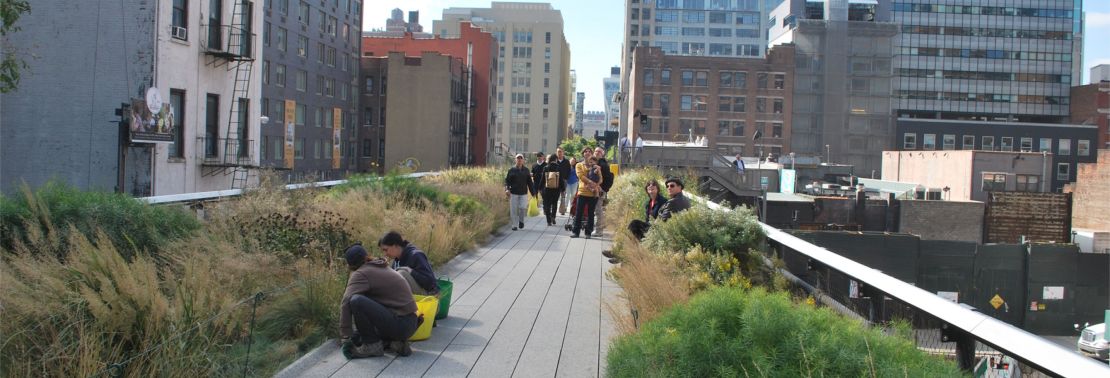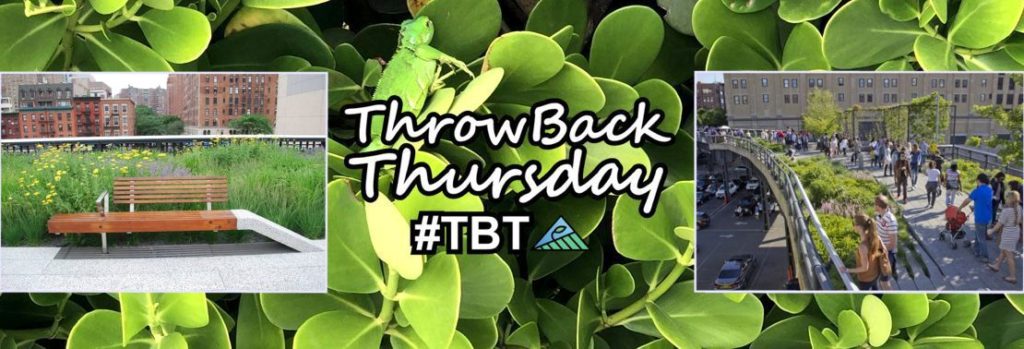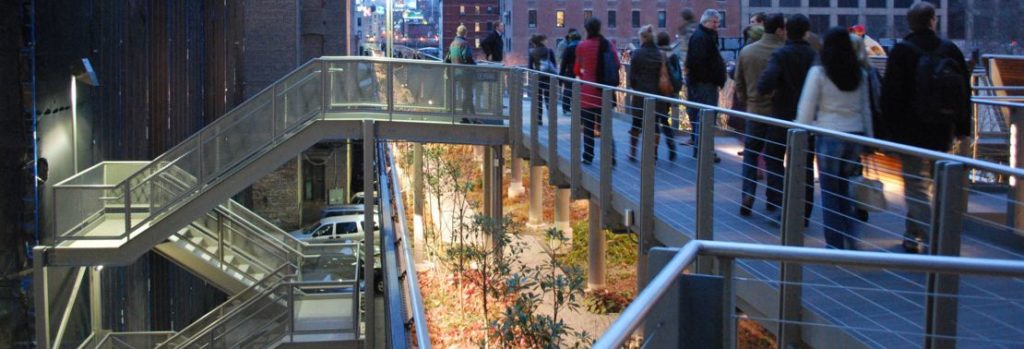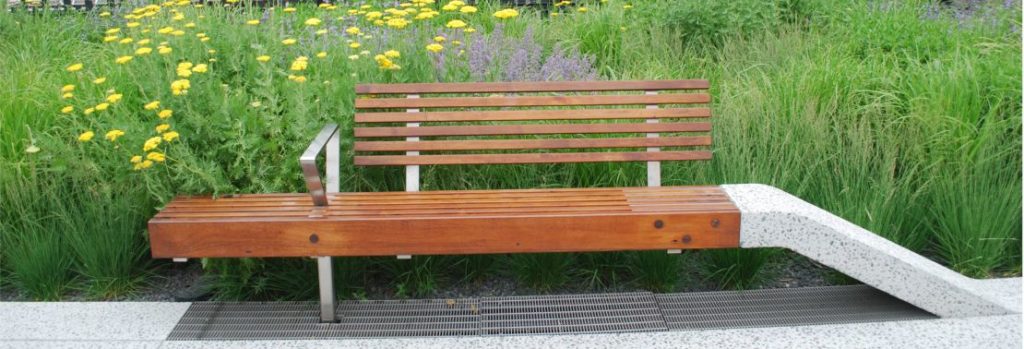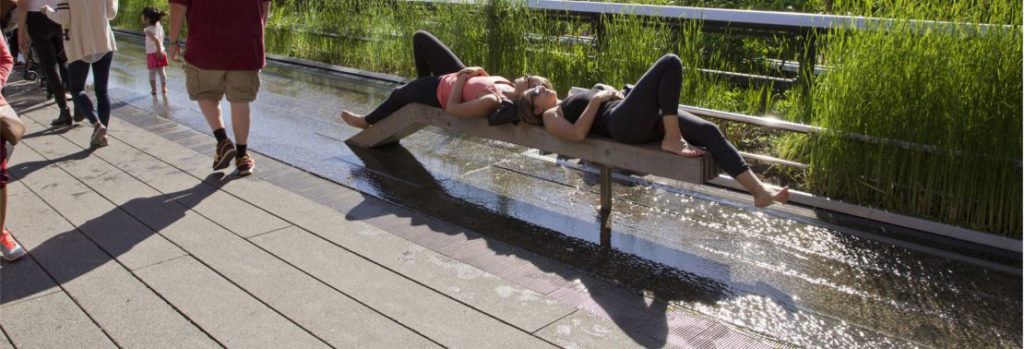A Comparison of the Three Phases of the High Line, New York City: A Landscape Architect and Photographer’s Perspective
“A Comparison of the Three Phases of the High Line, New York City: A Landscape Architect and Photographer’s Perspective” compares Phase One with Phase Two, and describes what is proposed for Phase Three. Design features to be reviewed include the walk system, seat furnishings, plantings, signage and graphics, water feature and drinking fountains, public art, lighting, maintenance and irrigation, and Phase 3. The author also offers suggestions on economic impacts, restrictions and user activities, sustainability, and studies/research.
Originally, due to the length and photo essay nature of the contribution, the series was presented approximately every few weeks in 14 parts between 2013 and 2015; to ensure background information, the Series Introduction is repeated on all.
Part 8 – Maintenance & Irrigation
By Steven L. Cantor, Landscape Architect – Originally Posted May 14, 2014
All Photos © Steven L. Cantor
Series Introduction

Phase One High Line on July 15, 2009.
Designed by landscape architect James Corner of Field Operations, architect Ricardo Scofidio of Diller Scofidio + Renfro with planting design by Piet Oudolf, the High Line, the remarkable linear park built on an abandoned railroad viaduct in New York City, has been enormously popular.
The design team anticipated how well green roof technology would function and adapt to the viaduct since it could handle at once the huge weight of several fully-loaded trains carrying heavy tonnage. As an intensive green roof, it has very few structural load limits which would curtail use. At peak use times there can be lines of pedestrians waiting to enter with as many as 20,000 visitors per day on weekends.[1]
The High Line has won numerous awards, and in particular several as a green roof, for example, in 2013 and 2010 from the American Society of Landscape Architects, Green Roofs for Healthy Cities in 2011, and in 2010 from the International Green Roof Association. This is a rare public project in which the success of the initial phase contributed to a high level of funding for subsequent phases.
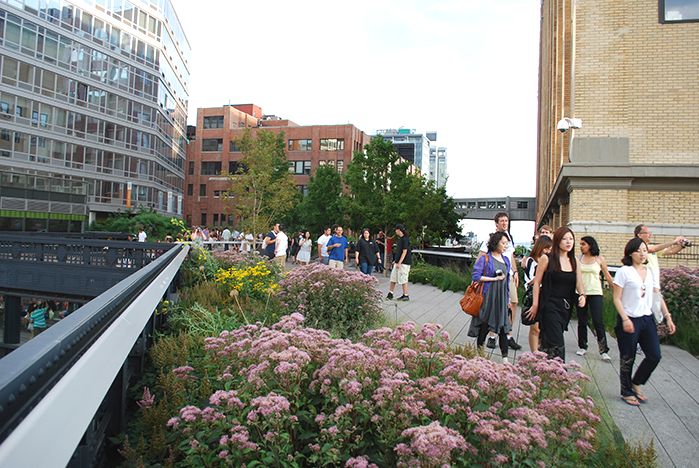
7.16.11.
The High Line has benefited from intense scrutiny as a result of lectures in which the designers were questioned; public hearings, media critiques in newspapers, journals, and blogs; lobbying from specific organizations, such as the Rainforest Coalition; and comments from city government and other public officials.
Improvements or adjustments were implemented to some design elements of the first phase, and significant modifications were done in the second phase. Are these changes aesthetic, appropriate and ethical, and are they consistent with the goals of sustainability? Is the High Line a sustainable design?
Part 8: Maintenance & Irrigation Discussion
Friends of the High Line, the advocacy group that helped bring about the creation of the High Line park, is currently maintaining the park in partnership with the New York City Department of Parks and Recreation. Maintenance issues are to be expected in such an innovative design, as some maintenance practices must evolve as gardeners and other staff find what methods work best.
To date the costs per acre for maintenance are considerably higher than any other park within the city’s park system, at $ 671,641 per acre or almost $ 1,679,000 per hectare (according to the New York Post). Phase One and Phase Two total 4.78 acres.[5]
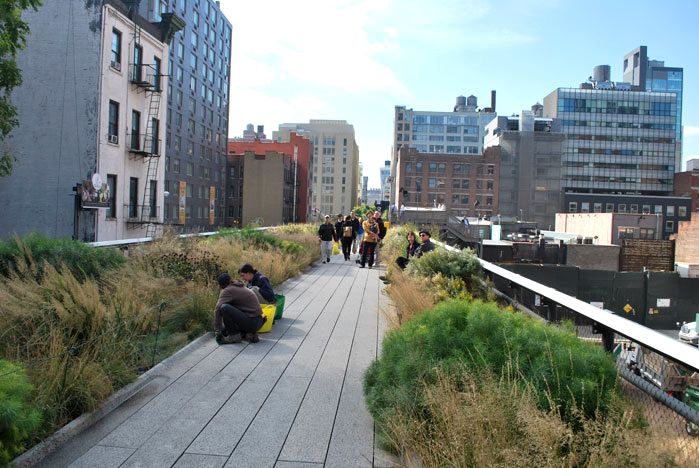
10.13.13.
The width of the High Line varies from 30 to 88 feet so it’s difficult to approximate the acreage of Phase Three which is being planned and partly under construction. Since the first two sections are each half a mile long, if one thinks of Section 3 as similar ball park dimensions, then the finished High Line could approximate 7 acres.[6]
This matches the proposed total area in an earlier 2002 planning study, yet I would not be surprised if this grand total increases as there are significant areas, such as the Gansevoort Street entrance where considerable at-grade areas directly below the High Line seem to be within the purview of the park.
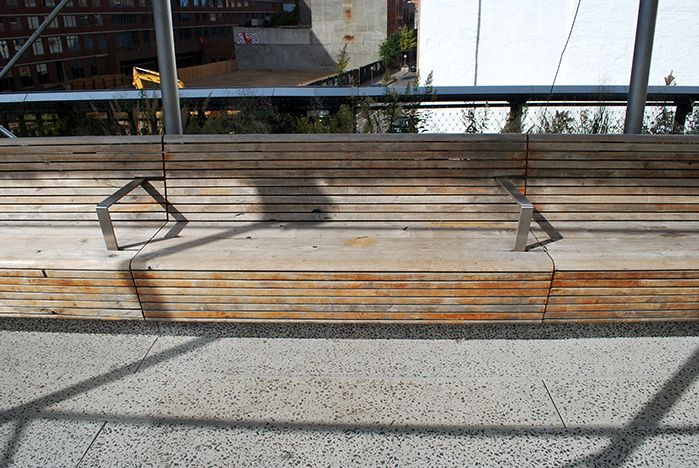
10.13.13.
The integrated nature of the design vocabulary, such as the benches, may create complex maintenance requirements, as removing one component for repair or replacement may be difficult. Although the park was first presented to the public as a natural landscape, it is a series of gardens requiring irrigation, pruning, deadheading, weeding, garbage pick-up, and the upkeep of the new knee-high cable system, the drinking fountains, the water feature, signage and lighting systems.
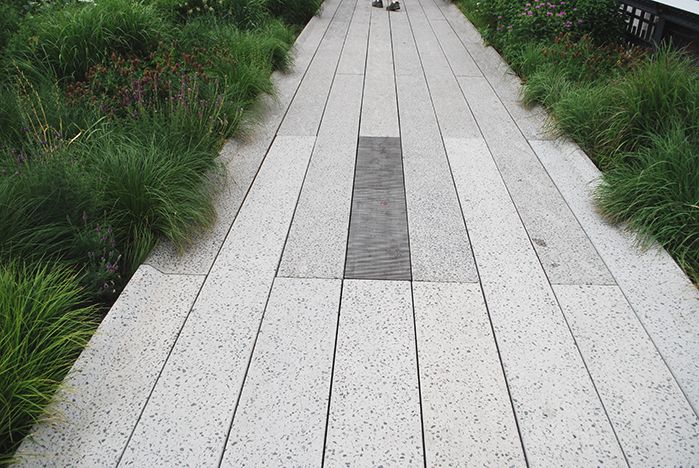
Looking south where Phase One work meets the newer Phase Two work, one can see a darker tone to the Phase One pavements since they have experienced a longer period of continual pedestrian use; 6.16.11.
The concrete plank pavement system is light colored, so it shows stains easily, a common sight since there are now many food carts and vendors. Wads or remnants of chewing gum are occasionally visible.
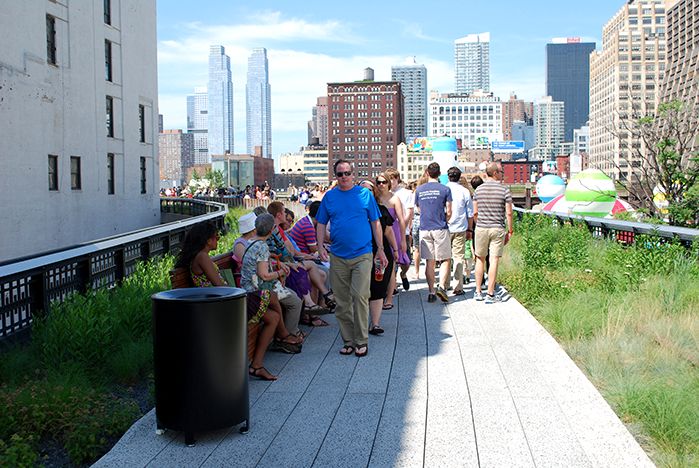
6.19.11.
There are an adequate number of trash receptacles; oddly, unlike the pavements and benches, they are not integrated in design. As a result their locations sometimes appear arbitrary or crowd the space near benches or other integrated design elements.
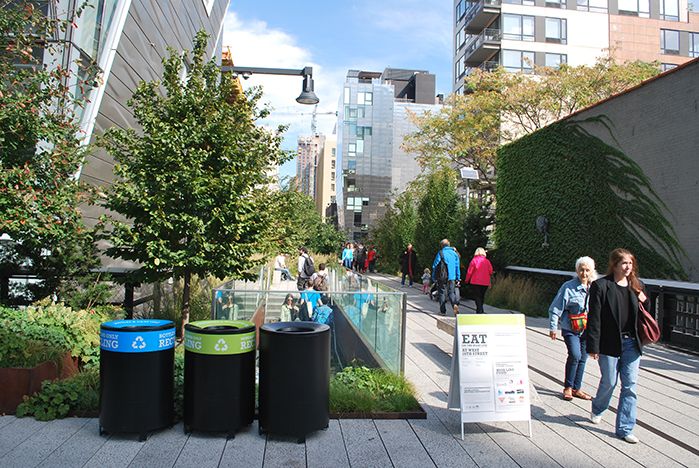
10.14.13.
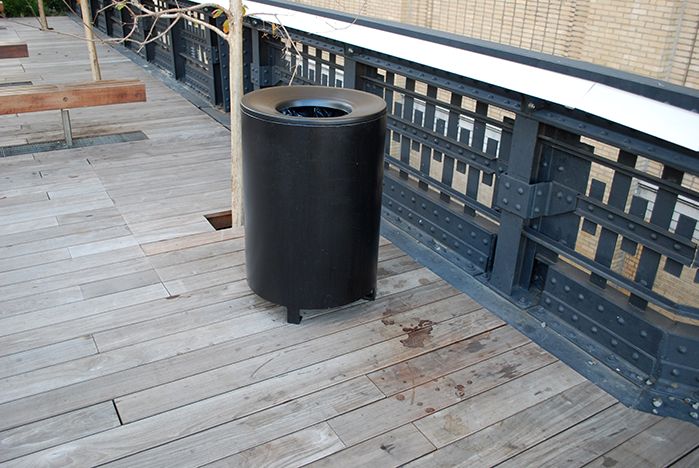
9.25.09.
There is rarely graffiti, as the park maintenance staff is sufficiently aggressive in cleaning and removing these as fast as possible. One afternoon I observed a team of High Line employees take stock of a newly stenciled advertisement. A phantom artist painted it on the pavement and then made a quick getaway. The work did not remain in place for long.
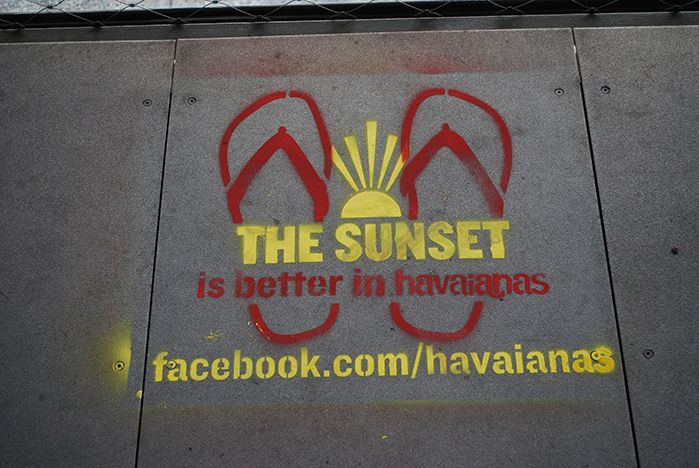
6.25.10.
Although over 75% of the more than 200 species of plants are native in the High Line, they come from many different regions and have different growth rates. Since in many locations native plant materials are combined with non-native ones or materials from different regions, how these plants will co-exist cannot be entirely predicted, so on occasions maintenance is expected to cut back overly aggressive plants, remove dead plants or encourage more tender ones.
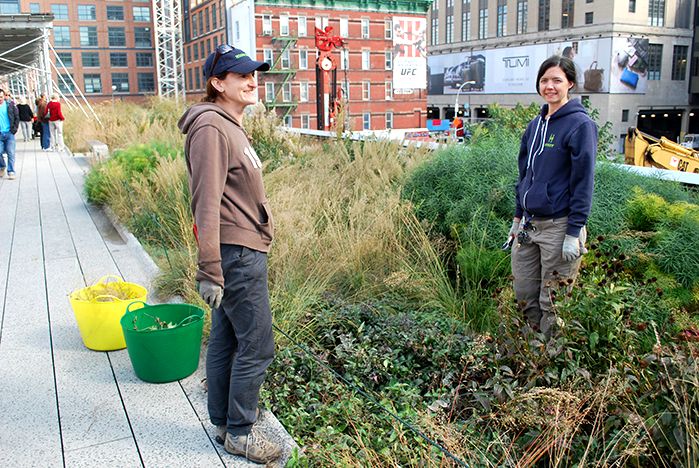
10.13.13.
The knee-high cable system was introduced after the High Line initially opened to prevent pedestrians from wandering into the planting beds and to help define the boundary between the pavements and the plantings, as the edge of the subtle, curving pavement design can sometimes be hard to perceive. The cable requires continual maintenance, as it is common for people to step on or lean against and bend the cable supports, and there is no standardized location for installation. I’ve noticed the ends of cables tied to benches or other random elements.
In all such projects there are some enjoyable surprises, such as plants that grow better than in their native environment, but also unexpected problems to fix, such as plants that die or are too aggressive.
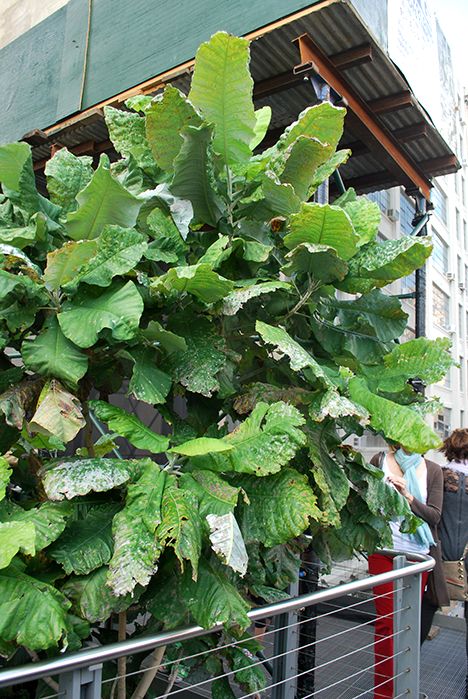
A stressed out magnolia; 10.13.13.
Finding the proper balance is always a challenge. In some green roofs the approach is to “let nature take its course,” and if some plants die out and others dominate, this is not a problem as long as the green roof is achieving its basic functions. This is not an effective management guideline for the High Line.
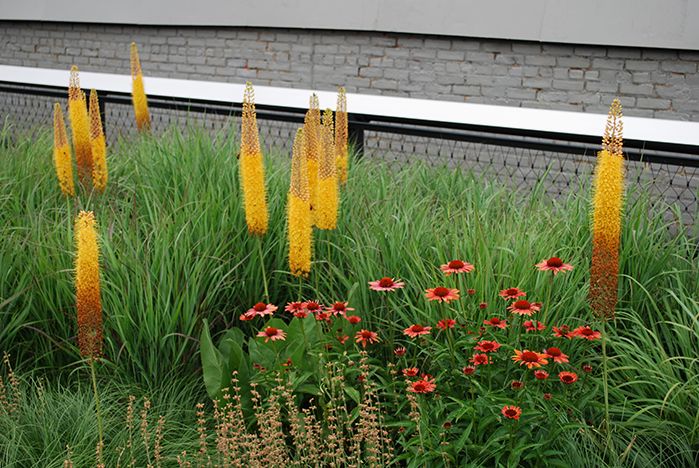
Foxtail lily, Eremurus stenophyllus, with Rudbeckia sp in foreground; 6.12.10.
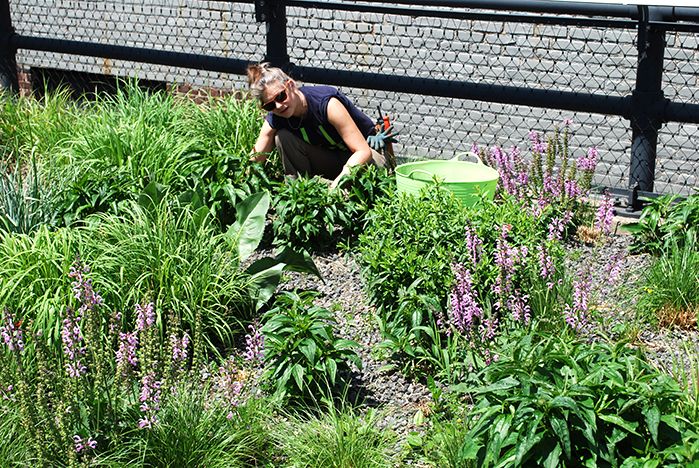
Maintaining perennials on 6.16.11.
There is a more comprehensive use of irrigation in the second phase than the first. In recognition that even predominantly native vegetation needs watering while it is getting established and during periods of drought, there was substantial manual irrigation in the first phase, while the second phase included drip irrigation throughout most of the planting beds, particularly in the forest of trees by the Falcone Flyover, where several species of magnolia are adapting well.
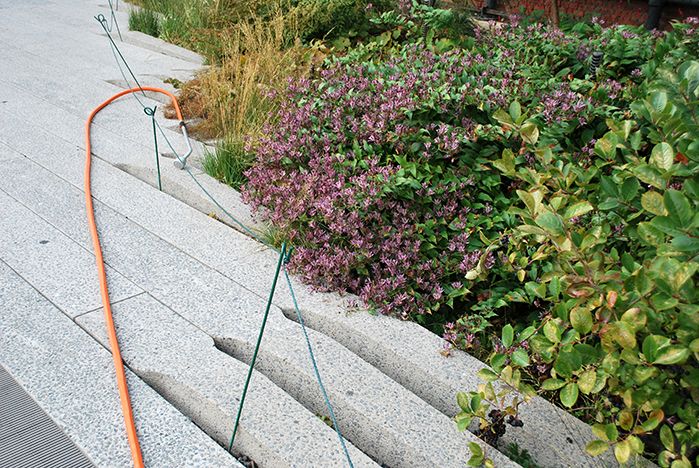
10.14.13.
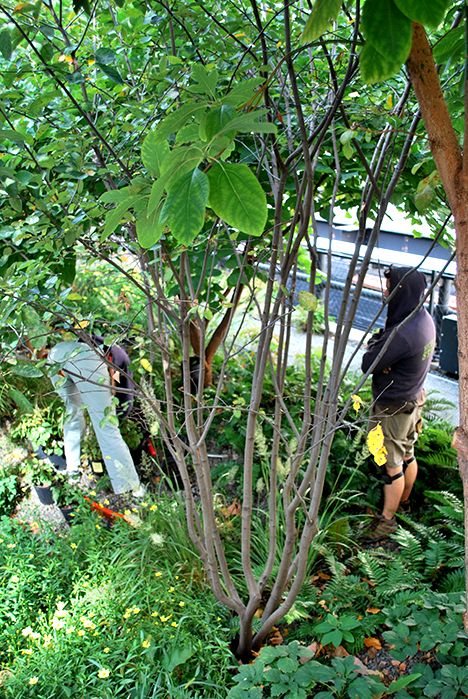
Magnolias; 10.13.13.
I’ve observed irrigation being added to areas which previously had only manual coverage, such as the principal lawn area (about 4,900 square feet) and some planting beds.
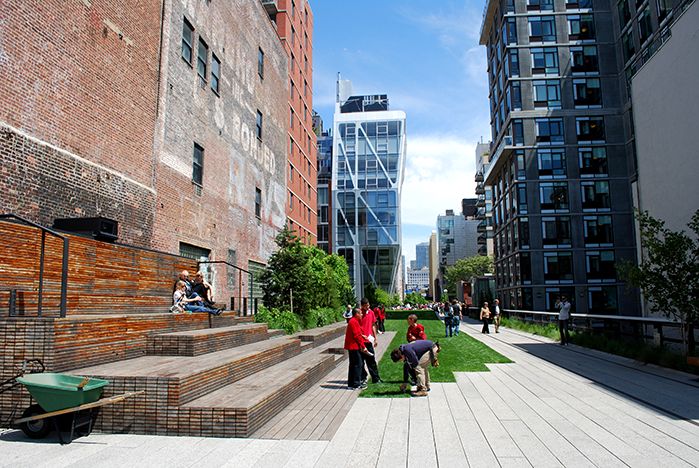
5.11.12.
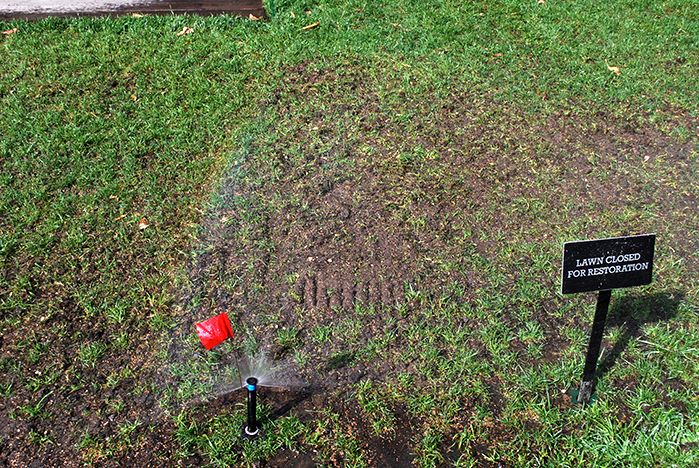
10.14.13.
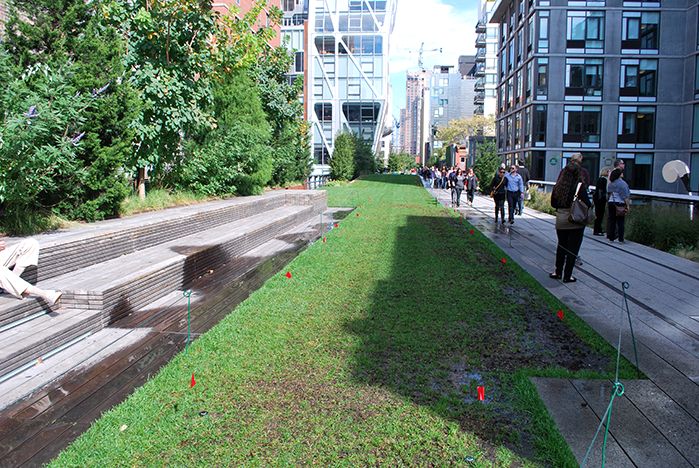
10.14.13.
It is very difficult to maintain thriving plantings, even of native plants, without a greater depth of soil and less wear and tear from pedestrians. The High Line is an intensive green roof with relatively shallow depths of substrate. The depth of soil is between 18 inches and 36 inches, where trees are planted.[7]
Many of the plantings on the High Line are native to deep, well watered soils, so irrigation is required when these same plants are situated at much shallower depths in the midst of adverse urban weather conditions. I believe the increase and upgrade in irrigation systems are a result of learning from the first phase that such maintenance is essential.
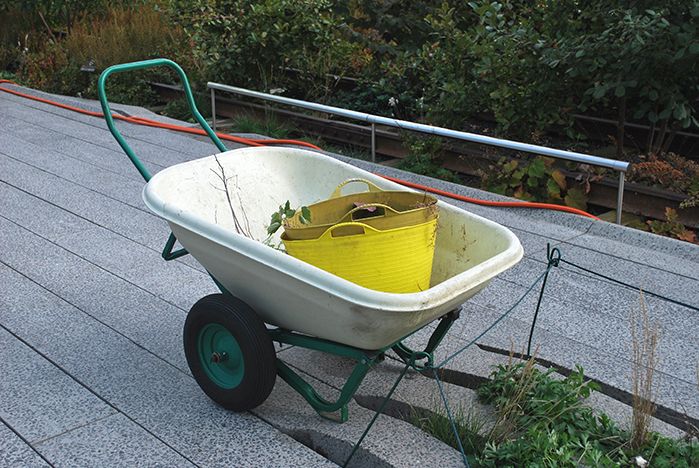
10.14.13.
Additional High Line Maintenance & Irrigation Photos
That’s it for now. I hope that these different sections of text and images of the High Line will generate discussion.
Come back next time for Part 9 of “A Comparison of the Three Phases of the High Line, New York City: A Landscape Architect and Photographer’s Perspective” where I’ll discuss Phase Three.
Steven L. Cantor
Photos © Steven L. Cantor are available for individual purchase.
Cumulative 14-part “A Comparison of the Three Phases of the High Line, New York City: A Landscape Architect and Photographer’s Perspective” Series End-notes
1. Ulam, Alex. “Back on Track,” Landscape Architecture Magazine. Volume 99, No. 10, October, 2009, p. 97.
2. http://www.thehighline.org/news/2012/01/24/major-milestone-for-the-high-line-at-the-rail-yards
3. http://www.thehighline.org/sustainability
4. http://www.thehighline.org/design/planting
5. Ulam, Alex. “Back on Track,” Landscape Architecture Magazine. Volume 99, No. 10, October, 2009, p. 97 and 105-106. He refers to an article in the New York Post.
6. David, Joshua, Reclaiming the High Line, a project of the Design Trust for Public Space with Friends of the High Line. Karen Hock, editor, (New York, Ivy Hill Corporation and others, 2002). p.7.
7. http://www.thehighline.org/about/ask-a-gardener
Publisher’s Note:
See Steven L. Cantor’s ENTIRE 14-part “A Comparison of the Three Phases of the High Line, New York City: A Landscape Architect and Photographer’s Perspective” Series.
Steven L. Cantor, Landscape Architect

Photo by Thomas Riis.
Steven L. Cantor is a registered Landscape Architect in New York and Georgia with a Master’s degree in Landscape Architecture from the University of Massachusetts, Amherst. He first became interested in landscape architecture while earning a BA at Columbia College (NYC) as a music major. He was a professor at the School of Environmental Design, University of Georgia, Athens, teaching a range of courses in design and construction in both the undergraduate and graduate programs. During a period when he earned a Master’s Degree in Piano in accompanying, he was also a visiting professor at the College of Environmental Design at the University of Colorado, Boulder. He has also taught periodically at the New York Botanical Garden (Bronx) and was a visiting professor at Anhalt University, Bernberg, Germany.
He has worked for over three decades in private practice with firms in Atlanta, GA and New York City, NY, on a diverse range of private development and public works projects throughout the eastern United States: parks, streetscapes, historic preservation applications, residential estates, public housing, industrial parks, environmental impact assessment, parkways, cemeteries, roof gardens, institutions, playgrounds, and many others.
Steven has written widely about landscape architecture practice, including two books that survey projects: Innovative Design Solutions in Landscape Architecture and Contemporary Trends in Landscape Architecture (Van Nostrand Reinhold, John Wiley & Sons, 1997). His book Green Roofs in Sustainable Landscape Design (WW Norton, 2008), provides definitions of the types of green roofs and sustainable design, studies European models, and focuses on detailed case studies of diverse green roof projects throughout North America. In 2010 the green roofs book was one of thirty-five nominees for the 11th annual literature award by the international membership of The Council on Botanical & Horticultural Libraries for its “outstanding contribution to the literature of horticulture or botany.”
Steven’s most recent book is Professional and Practical Considerations for Landscape Design (Oxford University Press, 2020) where he explains the field of landscape architecture, outlining with authority how to turn drawings of designs into creative, purposeful, and striking landscapes and landforms in today’s world.
He has been a regular attendee and contributor at various ASLA, green roofs and other conferences in landscape architecture topics.
In recent years Steven has had more time for music activities, as a solo pianist and accompanist. In 2011 he performed a solo piano program at the Winter Rhythms festival at Urban Stages Theater. He’s a regular performer at musicales hosted in Chelsea and other settings in Manhattan. On August 25, 2013, Leonard Bernstein’s birthday, he performed with Stephen Kennedy Murphy a program of excerpts from the composer’s MASS and Anniversaries.
Steven joined the Greenroofs.com editorial team in December, 2013 as the Landscape Editor. In February, 2015 he completed his 14-part series “A Comparison of the Three Phases of the High Line, New York City: A Landscape Architect and Photographer’s Perspective.”
 Greenroofs.comConnecting the Planet + Living Architecture
Greenroofs.comConnecting the Planet + Living Architecture
